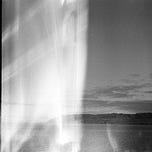To The Wind is a soundscape piece recorded over 25 days between 5th March and 3rd April 2020. Presented as 25 raw and untreated one-minute recordings made on the same spot in all conditions above Gallanach Bay, Isle of Muck, the idea began as an experiment to capture the changing weather patterns on the cusp of spring in the Hebrides. As it turned out, it would also present a very different archive of the first month of the Covid-19 pandemic, a document of a seismic moment in world history that is conspicuous in its absence from the recordings.
I have decided to share it five years on, not because it is a finished piece but because it also documents my process in getting to grips with using a field recorder for the first time. The recordings are crude and I really struggled with the wind (hang in there beyond day 4, I promise it improves), but heard with the benefit of hindsight, it also speaks to me about memory, beginnings and cycles of change that unfold over time frames bigger than those I understood in the moment.
During the weeks when I was making these recordings, I was also working through Cathy Lane and Angus Carlyle’s collection of interviews In The Field, reading an interview with a different practitioner every day, writing out quotes, reflecting on my own process and noting down the weather on the day of each recording. Here is an extract from the introduction, which I read before recording on the first day:
--
Day 1: Thursday 5th March, 2020
“Is the recordist an audible presence? Are they a silent participant who nonetheless provides some experiential authenticity, or at least takes responsibility for pressing “record” and then “stop”? Or is the recordist understood to be of relative insignificance compared to the dynamic properties of the scenes itself?” – Introduction, Lane & Carlyle
“If field recording is anything it involves an acceptance of the shifting circumstances of the world, the sudden, the gradual, the dynamic detail that duration reveals.” – Introduction, Lane & Carlyle
As the recordist, you must let go of your ideas of how the scene around you “should” sound, your preconceptions about what makes an “accurate”, “exciting” or “evocative” recording, and allow what exists in that moment to come to you. You must try to avoid imposing conditions or requirements on the recording, just as sketching is about freeing yourself from what you think you should be seeing (“an arm looks like this”) and capturing what’s actually there (“the angle of the arm”). The latter, although not always obviously descriptive, will always provide a more accurate representation.
“You can imagine a landscape where there are lots of things going on – such as different points on a map, for example – so when you are recording you are, in a sense, travelling through the map with these different locations and the composing then becomes the microphone’s movement through space.” – Andrea Polli, interviewed by Angus Carlyle (19)
So, what does that mean for a static microphone? Mapping the sound as it comes to you. There is an audible field, with boundaries to each recording, which extends in a radius of X from the microphone. Only that which enters this space will be captured.
How do you relate to wind? Wind is ever-present, but creates such static on the microphone as to obscure all other sounds. Should the recordist be actively monitoring and mitigating the intrusion of the wind into the recording (i.e. modifying the sensitivity of the mic in real time) or by framing win as an intrusion at all, the recordist is bringing their own preconceptions to the accuracy of the sonic environment, and unduly interfering with what is there? It is possible that the effect of the wind on the mic is exposing the limitations of the technology, in that, to the human ear, wind does not obscure all other sound in the way it does when rushing through the microphone. Should the recording be truer to the mic or the human ear? Probably the latter? And in mediating the recording of wind, the recordist inserts themselves into the act of documentation, in order to try and capture the environment in a fashion as close to their experience of it.
Conditions:
- Largely sunny, with a gentle breeze. Generally calm, although the breeze carries a chill.
- Isle of Eigg is clear, with soft blue sky and white clouds.
- The snow-capped peaks of Skye visible beyond Eigg, shrouded partially in cloud.






Share this post